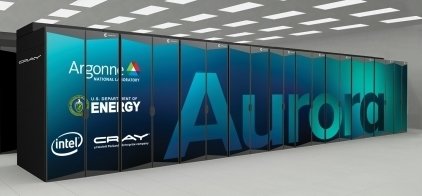 Intel and Argonne National Laboratory said today they are using GPUs based on Intel’s Xe-HP microarchitecture and Intel oneAPI toolkits for development of scientific applications to be used on the Aurora exascale system — in anticipation of later delivery of Intel 7nm ‘Ponte Vecchio’ GPUs, which will drive Aurora when the delayed system is deployed in 2022.
Intel and Argonne National Laboratory said today they are using GPUs based on Intel’s Xe-HP microarchitecture and Intel oneAPI toolkits for development of scientific applications to be used on the Aurora exascale system — in anticipation of later delivery of Intel 7nm ‘Ponte Vecchio’ GPUs, which will drive Aurora when the delayed system is deployed in 2022.
The goal: using Intel heterogeneous computing programming environments so that scientific applications are ready for the scale and architecture of the Aurora supercomputer at deployment.
The Aurora system (A21), for which Intel is the prime contractor, had been scheduled for deployment in 2021 and was intended to be the first exascale-class system in the U.S. But in July, Intel disclosed that its ‘Ponte Vecchio’ GPU, a key Aurora component, would be delayed at least six months, meaning that HPE-Cray’s Frontier, powered by AMD CPUs and GPUs and designated for Oak Ridge National Laboratory will the country’s first exascale system. (Note that at its HPC Market Update yesterday, industry analyst firm Hyperion Research said it expects Aurora to be delivered about 12 months behind schedule.)
In its announcement this morning, Intel said Argonne Leadership Computing Facility (ALCF) researchers are using software development platforms based on Intel Xe-HP GPUs as part of the Aurora Early Science Program and Exascale Computing Project, which are designed to prepare key applications, libraries and infrastructure for Aurora. Intel and Argonne teams are working together to co-design, test and validate several exascale applications.
“Having access to Intel Xe-HP GPUs and development tools enables Argonne developers to perform software optimizations across Intel CPUs and GPUs and investigate scenarios that would be difficult to replicate in software-only environments,” Intel said. “The Xe -HP GPUs offer a development vehicle to Intel Xe-HPC GPUs (Ponte Vecchio) that will be used in the Aurora system.”
 “Our collaboration with Intel in the area of cross architecture code development is benefitting many of our developer teams,” said Susan Coghlan, project director for Aurora at the ALCF. “This co-design approach has led to the software stack’s quick maturation to production quality for execution on Aurora.”
“Our collaboration with Intel in the area of cross architecture code development is benefitting many of our developer teams,” said Susan Coghlan, project director for Aurora at the ALCF. “This co-design approach has led to the software stack’s quick maturation to production quality for execution on Aurora.”
Examples of the development work include:
- The EXAALT project, which enables molecular dynamics at exascale for fusion and fission energy problems.
- The QMCPACK project, which is developing Quantum Monte Carlo algorithms at exascale to improve predictions concerning complex materials.
- The GAMESS project, which is developing ab-initio fragmentation methods to more efficiently tackle challenges in computational chemistry, such as heterogeneous catalysis problems.
- The ExaSMR project, which is developing high-fidelity modeling capabilities at exascale for complex physical phenomena occurring within operating nuclear reactors to ultimately improve their design.
- The HACC project, which is developing extreme-scale cosmological simulations at exascale that will allow scientists to simultaneously analyze observational data from state-of-the-art telescopes to test different theories.




